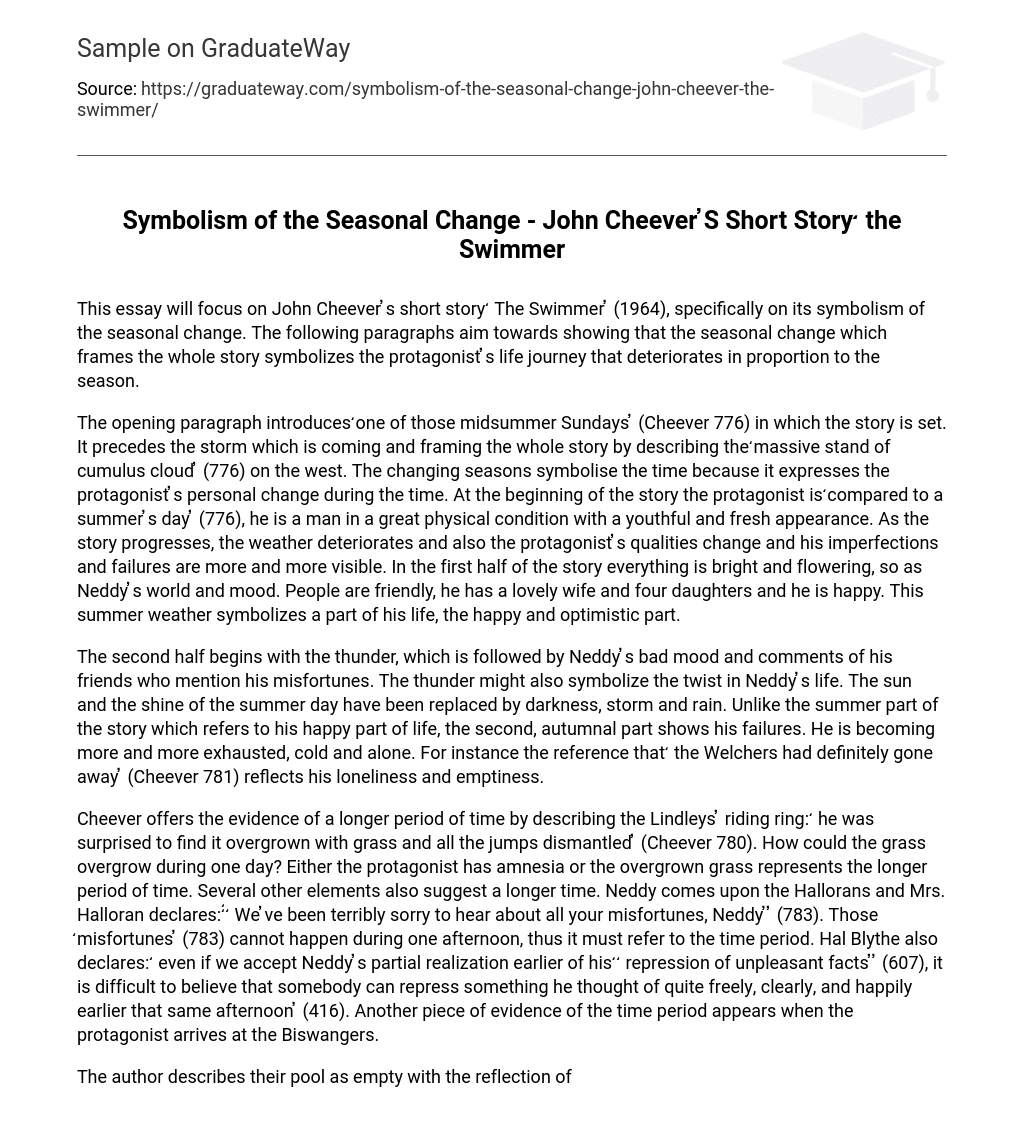This essay will focus on John Cheever ̓s short story ̒ The Swimmer ̓ (1964), specifically on its symbolism of the seasonal change. The following paragraphs aim towards showing that the seasonal change which frames the whole story symbolizes the protagonist ̓s life journey that deteriorates in proportion to the season.
The opening paragraph introduces ̒one of those midsummer Sundays ̓ (Cheever 776) in which the story is set. It precedes the storm which is coming and framing the whole story by describing the ̒massive stand of cumulus cloud ̓ (776) on the west. The changing seasons symbolise the time because it expresses the protagonist ̓s personal change during the time. At the beginning of the story the protagonist is ̒compared to a summer ̓s day ̓ (776), he is a man in a great physical condition with a youthful and fresh appearance. As the story progresses, the weather deteriorates and also the protagonist ̓s qualities change and his imperfections and failures are more and more visible. In the first half of the story everything is bright and flowering, so as Neddy ̓s world and mood. People are friendly, he has a lovely wife and four daughters and he is happy. This summer weather symbolizes a part of his life, the happy and optimistic part.
The second half begins with the thunder, which is followed by Neddy ̓s bad mood and comments of his friends who mention his misfortunes. The thunder might also symbolize the twist in Neddy ̓s life. The sun and the shine of the summer day have been replaced by darkness, storm and rain. Unlike the summer part of the story which refers to his happy part of life, the second, autumnal part shows his failures. He is becoming more and more exhausted, cold and alone. For instance the reference that ̒ the Welchers had definitely gone away ̓ (Cheever 781) reflects his loneliness and emptiness.
Cheever offers the evidence of a longer period of time by describing the Lindleys ̓ riding ring: ̒ he was surprised to find it overgrown with grass and all the jumps dismantled ̓ (Cheever 780). How could the grass overgrow during one day? Either the protagonist has amnesia or the overgrown grass represents the longer period of time. Several other elements also suggest a longer time. Neddy comes upon the Hallorans and Mrs. Halloran declares: ̒̒ ̒ We ̓ve been terribly sorry to hear about all your misfortunes, Neddy ̓ ̓ (783). Those ̒misfortunes ̓ (783) cannot happen during one afternoon, thus it must refer to the time period. Hal Blythe also declares: ̒ even if we accept Neddy ̓s partial realization earlier of his ̒ ̒ repression of unpleasant facts ̓ ̓ (607), it is difficult to believe that somebody can repress something he thought of quite freely, clearly, and happily earlier that same afternoon ̓ (416). Another piece of evidence of the time period appears when the protagonist arrives at the Biswangers.
The author describes their pool as empty with the reflection of twilight and that the pool has ̒ a wintry gleam ̓ (Cheever 785). The winter gleam indicates ice, which is a sign of a winter, thus there preview of another season. The author gives us a hint by mentioning the typical autumn stars (Andromeda, Cephus and Cassiopeia), which are the strong evidence of the time period and actual changing of the seasons. Finally, the storm reappears at the end of the story when Neddy arrives home, which he finds without his wife, children or anybody.
As the paragraphs above aim towards to clarifying, John Cheever ̓ s The Swimmer ̓ is symbolically framed by the seasonal changes which pass so as the protagonist ̓s life, which turns from happily ever after to depressively ever after.
Works Cited
Blythe, Hal and Sweet Charlie. ̒ Man-Made Vs. Natural Cycles: What Really Happens in ̒ ̒ The Swimmer. ̓ ̓ Studies in Short Fiction 19 (1990): 2-9 Web. 1 December 2012. Cheever, John. ̒ The Swimmer. ̓ The Stories of John Cheever. Moodle. Ed. Markéta Gregorová. 22 October 2012. Web. 7 Dec 2012





